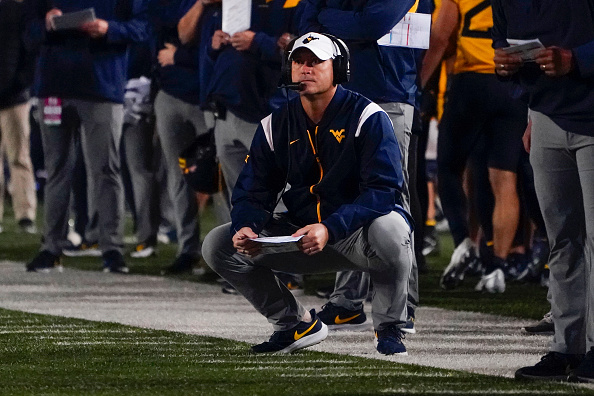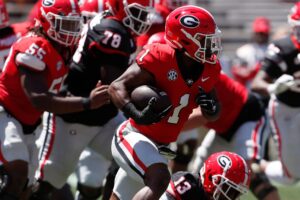To put it bluntly (but perhaps mildly), the West Virginia Mountaineers find themselves reeling after seven games. Head coach Neal Brown finds his leash shortening and his seat’s temperature rising quickly. Through 42 games under Brown, the Mountaineers post a 20-22 record. As Bill Parcells said, “you are what your record says you are.” If that is true, the Mountaineers, simply, are not very good. Even more, you have to go all the way back to the end of Frank Cignetti‘s era for the last time West Virginia has played this poorly on a consistent basis. The season, of course, still has five games left, so it is far from over. That said, the trends look bad, which leaves us wondering: what’s next for the Mountaineers?
What’s Next for the Mountaineers?
How the Sausage is Made
Despite Parcells’ well-known quote, the words oversimplify the notorious game of inches. If a team is truly a few plays away from a different outcome for a year and they return most people, well, that forecasts a different future than a team that still cannot climb the hurdle while enjoying veteran leadership. Thus, digging into the details of their 3-4 record this year and 20-22 record the last four years seems worthwhile.
This Year’s Performance
First, we look at 2022. West Virginia has played the 26th-strongest schedule in the nation. Three wins and four losses against that schedule look better than the same record against the worst schedule in the country. That said, in two of their four losses, the Mountaineers found themselves the victims of lopsided defeats. Texas beat them 38-20, and the score does not reflect just how convincingly the Longhorns controlled that game. Then, last week, Texas Tech absolutely crushed the Mountaineers 48-10. The 38-point loss represents the worst defeat suffered by a West Virginia team since, well, not that long ago when Oklahoma beat West Virginia by 38 in 2019. (The 36-point loss to Iowa State in 2020 comes close, too.) Prior to that, you have to go back to 2012 to find a worse loss (to Kansas State by 41).
Offensively, the Mountaineers definitely look better than they have to date under Brown. In the major statistical categories, the Mountaineers’ offense is top 50 in all of them. They are even in the top 25 in quite a few: 4th down conversion rate (14th), first downs (22nd), red zone offense (12th), and rush yards per attempt (16th).
The team, however, seems to have a Jekyll and Hyde problem, though. While the offense has been inept the last three years, the defense has been average to very good. This season, the defense has regressed significantly. The unit finds itself ranked worse than 100th in several major categories: third-down percentage (103rd), fourth-down percentage (126th), passing yards allowed (117th), turnover margin (102nd), and scoring defense (117th).
The Performance Under Brown
Under Brown, West Virginia seems to lose lopsided games at a pretty decent clip. Last week was the fourth loss of 30 or more points in three-and-a-half years under Brown. What does that mean exactly? By itself, not a whole lot. Indeed, this preseason we looked closely at single-score games under Brown’s tenure and thought that the addition of a solid signal caller and offensive coordinator might turn a few of those wins into losses.
That said, we found ourselves looking at more of the same early this season. One could argue with a straight face that West Virginia was three or four plays shy of starting the season 4-0. This is true. Since then, however, the gap between a win and a loss has grown substantially. In year four, however, fans do not want to “take solace” in single-score losses any longer. In year one, you can forgive a 5-7 record when the team loses two games by a single score (by three to Baylor and by seven to Oklahoma State). Why? Because you can say with a straight face that a team that replaced well over half of its starters was just a few plays away from 7-5. Hope can be found easily, even if the team lost four games by more than 21 points (and two by more than 30)
In the 2020 COVID-shortened season, you can also look at a 6-4 final record and see two games with one-score losses. One can easily look and see improvement, especially when the blowout losses get cut to one. Maybe one can even overlook year three which offers a slight regression in terms of wins and losses but features three games by single-score losses (Maryland by six, Oklahoma by three, and Texas Tech by three) but only a single blowout loss (by 25 to Baylor).
But when you’re already looking at two blowout losses without even playing the absolute toughest part of your schedule in year four, the outlook can sour quickly.
So, What’s Next?
That history has fans asking, “what’s next for the Mountaineers?” The question is fair. The answer, if it does not lead to more wins and support, seems downright alarming weighed against the backdrop of ongoing realignment. Shades of the late 2000s remain. During the most recent realignment, however, West Virginia enjoyed three straight 11-win seasons followed by thee straight nine-win seasons. Even with that, it took hard pushback against serious political pressure for the program to find its way safely into the Power Five.
Against that history, fans remain understandably nervous. Add that to the impatience of losing, and we would not be surprised if attendance at home games falls short of 50% of capacity barring a rapid turnaround. If the Mountaineers suffer another blowout loss this weekend to TCU, well, things will get ugly.
The cheapest long-term option is that Brown turns it around, and quickly. Short of that, we would be foolish not to start thinking about numbers.
Brown’s First Contract and Subsequent Extension
Brown’s initial contract with West Virginia paid him over $19 million through December 31, 2024. Under that contract, the school’s buyout obligation went down to 75% after the 2020 season. If the parties did not extend his contract, then the school’s buyout obligation would fall below $5 million (including the remainder of this year’s salary) if Brown were fired today.
After the 2020 season, Athletic Director Shane Lyons extended the contract and gave Brown a raise. Plenty wondered about the move at the time, as the progress in 2020 represented an incremental improvement, and Brown still had much to prove. That said, rumors persistently flew about Brown’s name coming up in job opening after job opening. Maybe this played a part.
Nonetheless, the extension kept Brown here through the end of the 2026 season and agreed to pay him $23.85 million through the end of the term. It also changed the buyout structure. If West Virginia fires Brown at any time before December 31, 2024, it will owe his remaining salary. As of that, that number is not what it has been reported to be ($20 million) as Brown has already earned most of his 2022 salary. Indeed, it is far closer to the accurately-reported $16.7 million that would be due if he were fired on January 1. The buyout percentage does not drop until January 1, 2025, when it goes to 85% of his remaining salary. Still, the obligation due if Brown were fired today would come out to around $17.2 million.
The extension, then, makes a $12 million difference, considering only Brown’s contract.
Is That the Actual Cost?
Contracts are funny things, though. Very rarely does a contract paint a one-sided picture. Indeed, Brown’s contract contains a few typical features that favor the schools. First, if West Virginia fired Brown today, the entire buyout is not due in a lump sum payment. It is payable over time, just as his salary would be. Second, the contract contains a clause that allows the University to reduce the buyout by any salary Brown earns from any other source for a football-related job through the end of the 2026 season. Finally, it technically allows the school to keep Brown on staff but relegate him to a lesser role, something that would be undesirable for both sides, but far less desirable for Brown, who will remain ambitious no matter what decision is made between now and January.
What does this mean? Well, it means the school has bargaining power. It means that Brown will not receive $16.7 million. Indeed, we would imagine that number would be $11 million or less based on similar outcomes over the last several years. Still, that number more than doubles what WVU would owe absent the extension. Lyons may answer for that, too, unless the team completes a sudden and complete turnaround. Unlikely as that seems, strangers things have happened.






